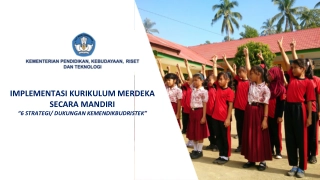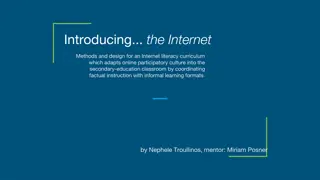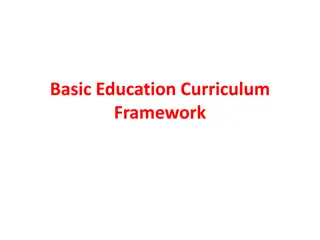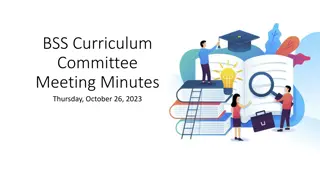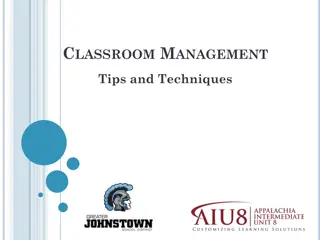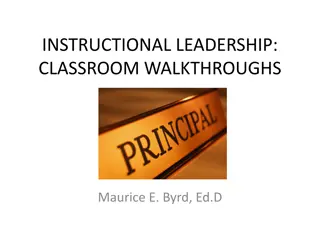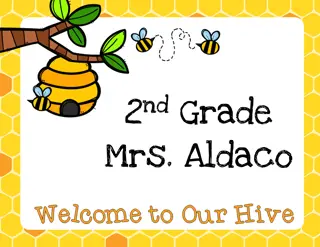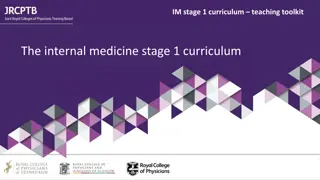Implementing a Curriculum: Key Steps for Classroom Organization and Community Building
Begin implementing a curriculum by organizing the classroom into interest areas like dramatic play, manipulatives, and music. Establish daily routines/schedule to create a structured environment. Focus on building a classroom community by fostering relationships with each child and emphasizing the importance of play and developmentally appropriate practices.
- Curriculum implementation
- Classroom organization
- Daily routines
- Classroom community
- Developmentally appropriate practices
Download Presentation

Please find below an Image/Link to download the presentation.
The content on the website is provided AS IS for your information and personal use only. It may not be sold, licensed, or shared on other websites without obtaining consent from the author. Download presentation by click this link. If you encounter any issues during the download, it is possible that the publisher has removed the file from their server.
E N D
Presentation Transcript
The first step towards implementing a curriculum is to:
Organize the classroom into interest areas Blocks Dramatic play Manipulatives (toys and games) Art Library Discovery/Science: Sand and water Music and movement
Organize the classroom into interest areas (cont.) Cooking Computers Outdoors
Establish daily routines/schedule (children know what to expect, and they understand what is expected of them): Arrival Group time Breakfast Choice time Outdoor play Music
Establish daily routines/schedule (cont.) Lunch Nap time Snack Departure
Create a classroom community Build relationship with each child: get to know each child; talk to children respectfully; be sensitive to children s feelings, acknowledge children s accomplishments and progress Help children to make friends: help them to cooperate, share, take turns, show empathy, and help others. Pair children to work on tasks, help them to negotiate and solve conflict
Importance of Play Developmentally Appropriate Practice: teaching children in ways that match the way children develop and learn; provide children challenging, but not overwhelming activities, so they can learn and practice newly acquired skills.
Developmental Stages of Play 1. Unoccupied behavior during infancy, a child occupies himself by watching anything of momentary interest http://child-care-preschool.brighthorizons.com/~/media/bh/centers/0352/galleries/theworldofinfants-photo-3122014120000am/6353024330202032031013466jpg635302433022853469.ashx?bc=whitemw=438thn=0
Stages of Play (cont.) 2. Onlooker play young toddlers focus on the activity rather than the environment
Stages of Play (cont.) 3. Solitary play (toddlers) the child plays alone without the regard to what other children are doing
Stages of Play (cont.) 4. Parallel play (ages 2-3) a child sitting next to another child, playing with the same toys, but in a different way. It is the early stage of peer interaction, but the focus is on the object rather than another child
Stages of Play (cont.) 5. Associative play (ages 3-4)- a child goes in and out of the play with other children, uses same toys and participates in the same activity, but in his own way
Stages of Play (cont.) 6. Cooperative play (ages 4 and up) group play that involves organized ideas, assigned roles, taking turns, making friends, organizing games and activities
Fostering Play Create a positive and safe place for play Provide open-ended play materials Respect and encourage individual differences in play abilities Have patience with children and give them time to learn new play skills Introduce activities and materials appropriate for each child s age and stage of development Make available culturally diverse materials for all children to enjoy and learn from as they play
Encourage cooperation Allow children extra time to finish activities Take time to listen to children as they play and to observe how each child plays, what he plays with, who he plays with, and what the child can do
Communication with Families Team work is crucial for the children success Respect families because they are primary educators of their children There is a learning process that the teachers and families always face. The teacher is learning from the children and their families When assessing child s needs and progress, consider the child's culture A teacher is prepared to meet the special needs of individual children, including those with disabilities
https://www.youtube.com/watch?v=HQKD5evdcrg (Reggio Environment)



